Overview
Diabetes Mellitus Type 2 is a chronic metabolic disorder that many people face, characterized by insulin resistance and a relative deficiency in insulin production. This condition leads to elevated blood glucose levels, which can feel overwhelming. Unlike Type 1 diabetes, where insulin production is absent, individuals with Type 2 can still produce insulin. However, their bodies struggle to utilize it effectively. It's understandable to feel concerned about the potential health complications that can arise if this condition is not managed properly.
As you navigate this journey, remember that you're not alone. Many individuals share similar experiences, and there are resources available to help you manage your health. We encourage you to seek support and learn more about how to live well with diabetes. Together, we can work toward better health and understanding.
Introduction
In today's world, where chronic diseases are increasingly common, Type 2 diabetes emerges as a significant public health challenge, impacting millions of lives across the globe. It's essential to understand this complex condition, which involves not just the biological mechanisms of insulin resistance but also the lifestyle factors that play a role in its rise. With concerning statistics showing a sharp increase in cases, the urgency for comprehensive education and support has never been greater.
It's understandable to feel overwhelmed when facing a diagnosis. Recognizing early symptoms and exploring effective management strategies can empower individuals to improve their health outcomes significantly. This article aims to navigate the intricacies of Type 2 diabetes, offering valuable insights and resources for those on this journey. Remember, you are not alone in this; we are here to support you every step of the way as you take charge of your health.
Understanding Diabetes Mellitus Type 2: A Comprehensive Definition
Diabetes Mellitus of the second variety is a chronic metabolic condition that many people face. It is characterized by insulin resistance and a relative shortage in insulin production, leading to elevated blood glucose levels—a state known as hyperglycemia. Unlike the first type, where the pancreas fails to produce insulin, those with the second type can still produce insulin; however, their bodies struggle to use it effectively.
This dysfunction can lead to a range of serious health issues, including cardiovascular disease, kidney damage, and neuropathy. It's understandable to feel concerned about these potential complications.
The prevalence of this condition has reached alarming levels worldwide. The International Diabetes Federation estimates that around 537 million adults were living with it in 2021, with expectations to rise to 643 million by 2030. This increase is closely linked to rising obesity levels, sedentary lifestyles, and genetic factors, making it a significant public health concern.
Recent research highlights the role of insulin resistance in the development and progression of Type 2 diabetes. Factors like obesity and lack of exercise can intensify insulin resistance, creating a harmful cycle. For example, a notable study titled "Trends in Diabetes Incidence Among U.S. Adults" indicated that while the overall age-adjusted incidence of diagnosed conditions remained stable from 2000 to 2021, significant variations across different U.S. counties underscore the need for targeted public welfare interventions.
The Global Burden of Disease study provides thorough worldwide statistics, analyzing trends for mortality and morbidity from significant illnesses. This enhances the reliability of the information available to you.
Healthcare professionals stress the importance of early diagnosis and treatment of Type 2 diabetes to mitigate long-term effects. Understanding the nuances of this condition is crucial for those newly diagnosed, as it empowers you to make informed choices about your well-being. T2DSolutions aims to be a supportive resource center for glucose-related education and community assistance, offering essential information and tools to help you navigate your health journey.
A collaborative approach to managing diabetes—incorporating lifestyle changes, medical treatments, and community support—is vital for improving health outcomes and enhancing the quality of life for those affected.
In summary, a comprehensive understanding of Diabetes Mellitus Type 2 encompasses its definition, key characteristics, and the latest research on insulin resistance. By grasping the implications of this condition, you can better navigate your health journey and engage with the resources available through T2DSolutions. Remember, you're not alone in this journey; we are here to support you every step of the way. A Zumla emphasizes the importance of assistance for research and readiness concerning the management of this condition, highlighting the collaborative effort needed to tackle this growing health challenge.
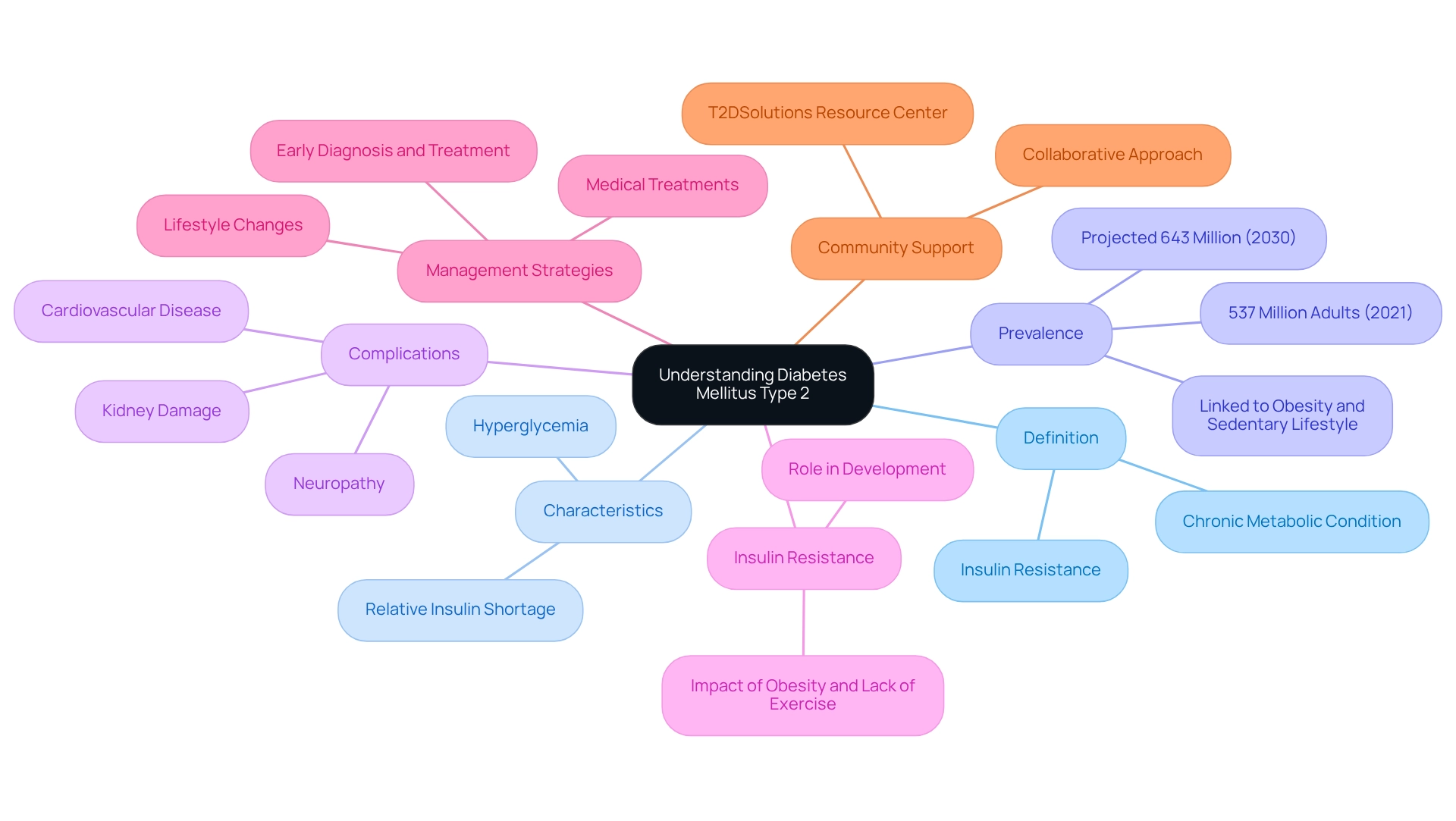
Classification of Diabetes: Types and Their Implications
This condition is primarily categorized into three main types: Type 1, Type 2, and gestational diabetes. Type 1 is an autoimmune disorder where the immune system mistakenly attacks and destroys insulin-producing beta cells in the pancreas, resulting in a complete lack of insulin. This type often appears in childhood or adolescence, though it can develop at any age.
On the other hand, diabetes mellitus type 2 is characterized by insulin resistance, meaning the body's cells do not respond effectively to insulin. This metabolic disorder is frequently associated with obesity, sedentary lifestyles, and genetic factors, making it increasingly prevalent in our society today. In fact, type 2 diabetes accounts for approximately 90-95% of all diabetes cases worldwide.
Gestational diabetes is another significant category, occurring during pregnancy. While it typically resolves after childbirth, it can increase the risk of developing Type 2 diabetes later in life for both mother and child. Understanding these classifications is crucial for healthcare professionals to develop appropriate treatment plans tailored to each patient's needs.
The urgency of addressing this condition as a public health crisis is underscored by recent statistics. In 2024, diabetes was responsible for 3.4 million deaths, translating to one death every six seconds. Additionally, the economic burden has escalated, with healthcare expenditures reaching at least USD 1 trillion—an astonishing 338% increase over the past 17 years.
This highlights the essential need for effective management strategies and community support. T2DSolutions actively advocates for resources that focus on education and oversight.
Real-life examples illustrate the importance of these classifications. Individuals with Type 1 diabetes require lifelong insulin treatment, while those with Type 2 may manage their condition through lifestyle changes, oral medications, or insulin therapy as needed. Case studies comparing treatment outcomes show that early intervention and comprehensive management can significantly improve health results for both types of diabetes.
For instance, the upcoming World Diabetes Day 2024 webinar aims to break barriers and bridge gaps in care through collaboration among stakeholders, aligning with T2DSolutions' mission to foster a supportive community.
Furthermore, it's important to acknowledge the emerging concept of Type 3 Diabetes, which is linked to Alzheimer’s disease and insulin resistance in the brain. This emphasizes the ongoing need for education and awareness in managing blood sugar conditions. By promoting a community-focused approach, T2D Solutions strives to empower individuals with the knowledge and tools necessary for effective management of their condition, including educational resources and community support programs that will be available upon the site's launch.
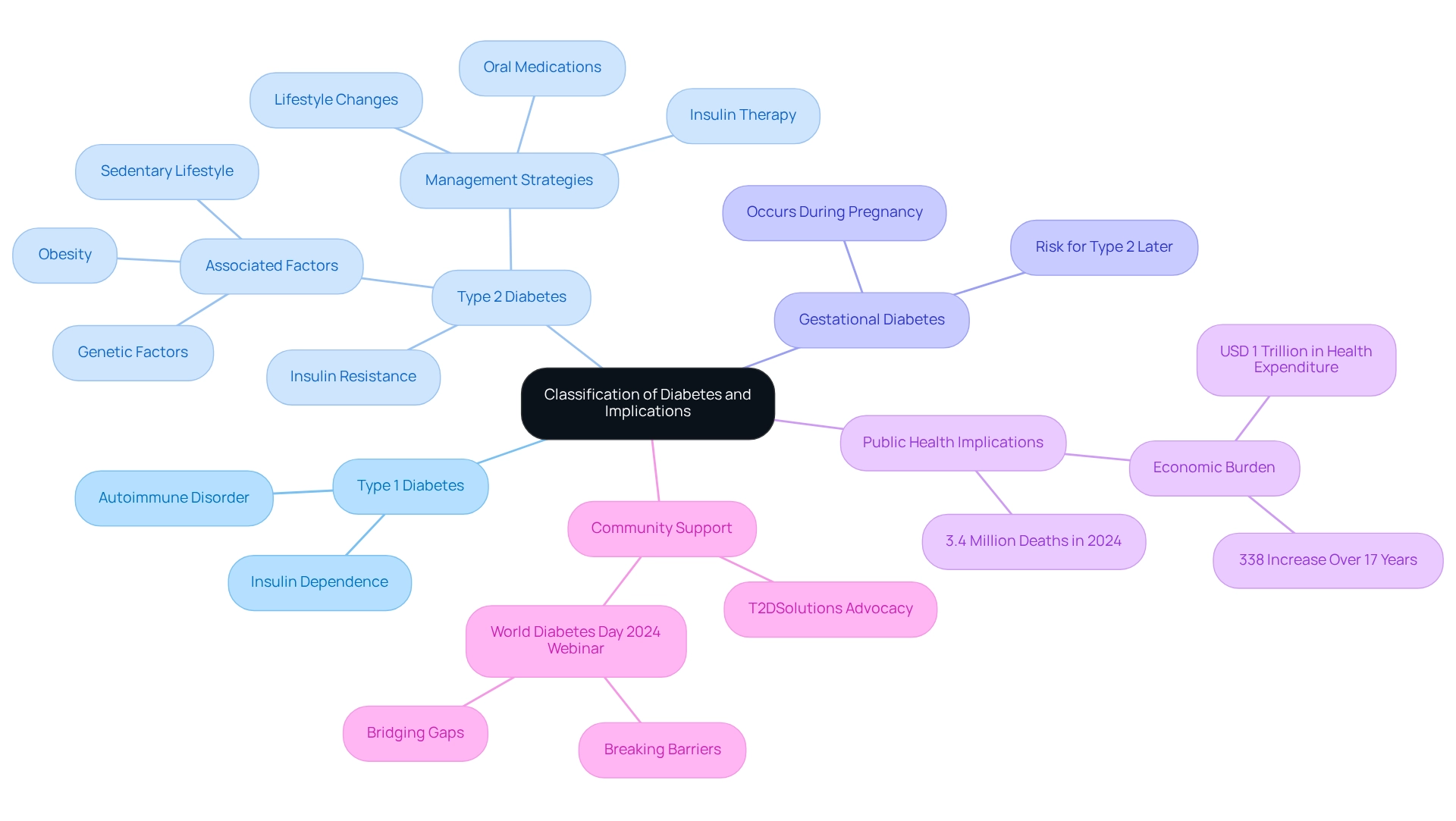
Diagnostic Criteria for Diabetes Mellitus Type 2: What You Need to Know
The definition of diabetes mellitus type 2 is based on specific criteria established by leading health organizations. These criteria include:
- A fasting plasma glucose level of 126 mg/dL (7.0 mmol/L) or higher
- A 2-hour plasma glucose level of 200 mg/dL (11.1 mmol/L) or higher during an Oral Glucose Tolerance Test (OGTT)
- An A1C level of 6.5% or higher
Additionally, a random plasma glucose level of 200 mg/dL (11.1 mmol/L) or higher in a patient showing classic symptoms of hyperglycemia can also suggest the presence of this condition.
Understanding the importance of early diagnosis is crucial. It allows for prompt intervention and oversight, ultimately preventing complications related to diabetes. For instance, a study named "Stress Management in Diabetes Care" emphasized that incorporating stress-reducing approaches—such as physical activity, sufficient sleep, and relaxation methods—can greatly improve diabetes care and enhance overall health outcomes.
Current statistics reveal a concerning trend: the number of identified type 2 diabetes cases continues to rise. The total estimated expenses of diagnosed diabetes in the U.S. reached $413 billion in 2022, an increase from $227 billion in 2012. This figure highlights the urgent need for effective diagnostic practices and early intervention strategies. According to the most recent guidelines, the definition of diabetes mellitus type 2 remains unchanged, emphasizing the need for healthcare providers to inform patients about the importance of blood glucose control in preventing complications.
As Rajeev Goyal pointed out, "Patients need to be informed about the significance of blood glucose control to prevent complications related to DM."
Real-world examples of early diagnosis illustrate the effectiveness of these criteria in clinical settings. They enable healthcare professionals to apply personalized care strategies that cater to each patient's unique needs. By adhering to established diagnostic standards, healthcare providers can play a vital role in enhancing the quality of life for individuals managing this condition. Furthermore, average medical costs among individuals with diagnosed health issues related to blood sugar are 2.6 times higher than expenses would be without the condition. This underscores the economic implications of effective management and early diagnosis.
At T2DSolutions, we are dedicated to being a comprehensive resource center for individuals recently diagnosed with type 2 diabetes. Our mission is to provide education and community support, helping patients understand their diagnosis and manage their condition effectively. Through our resources, we aim to empower patients with the knowledge and tools necessary to navigate their health journey successfully. Remember, you're not alone in this journey—we are here to support you every step of the way.

Identifying Risk Factors: Who is at Risk for Type 2 Diabetes?
To accurately evaluate your own risk and implement preventive strategies, it's important to recognize that diabetes mellitus type 2 is a non-insulin-dependent blood sugar disorder influenced by several risk factors. Being overweight or obese significantly increases the likelihood of developing this condition. Unfortunately, the prevalence of obesity is rising across various age groups, with many adults classified as overweight based on Body Mass Index (BMI) thresholds.
For instance, a BMI of 25 or above typically classifies most adults as overweight, although specific thresholds for Asian Americans and Pacific Islanders may vary, suggesting an increased risk of Type 2 conditions.
A sedentary lifestyle is another significant factor; individuals who engage in minimal to no physical activity are more prone to developing this health issue. Age also plays a role, as those over 45 years old face an increased risk. Moreover, family history is a crucial indicator; having relatives with this condition can elevate your likelihood of developing the illness.
Certain ethnic groups, including African Americans, Hispanic Americans, Native Americans, and specific Asian American populations, face a greater risk due to genetic and environmental influences. Additionally, health conditions such as high blood pressure and abnormal cholesterol levels further compound this risk. Women with a history of gestational conditions are also more likely to experience a form of blood sugar imbalance later in life.
Recognizing these risk factors is essential for everyone, especially those who may be at high risk. Engaging in preventive measures—such as maintaining a healthy weight, increasing physical activity, and monitoring blood pressure and cholesterol levels—can significantly reduce the likelihood of developing diabetes mellitus type 2. At T2DSolutions, we are here to support newly diagnosed patients by providing educational resources and community support to help you understand and manage these risk factors effectively.
Current statistics indicate that the median incidence of diagnosed conditions has seen slight fluctuations, with 9.7 per 1,000 people in 2004 compared to 9.0 per 1,000 in 2020. This highlights the continuous necessity for awareness and proactive health care, particularly since uncontrolled blood sugar can lead to severe issues like permanent vision impairment and foot complications, including ulcers and possible amputations. To remain informed about resources for education and control of blood sugar conditions, consider subscribing to T2D Solutions for updates. You're not alone in this journey; we are here to support you every step of the way.
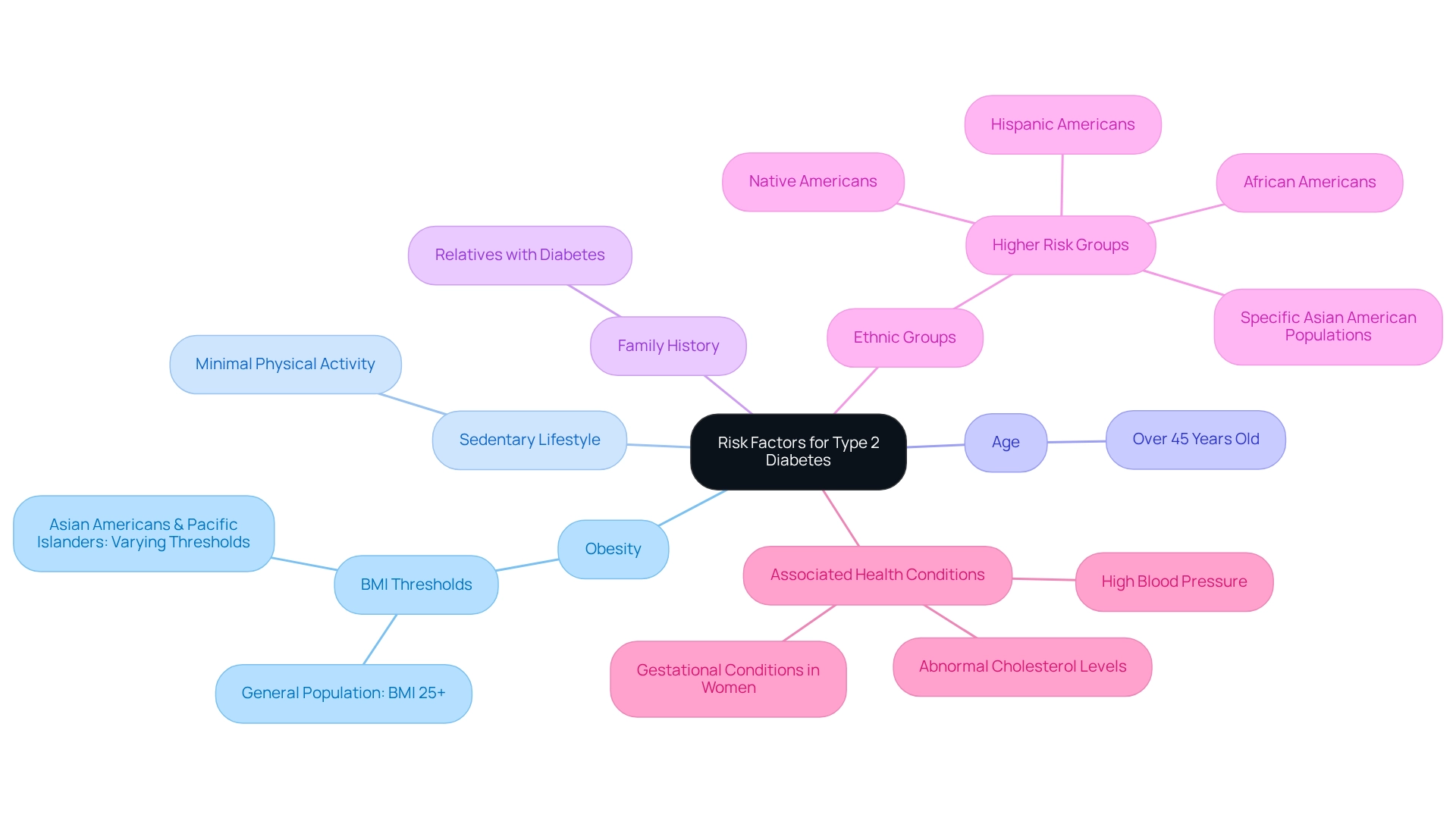
Recognizing Symptoms: Early Signs of Type 2 Diabetes Mellitus
The definition of diabetes mellitus type 2 encompasses common symptoms that manifest as various physical signs, which can significantly impact everyday life. These include:
- Increased thirst
- Frequent urination
- Extreme hunger
- Fatigue
- Blurred vision
- Slow-healing sores
Additionally, some individuals may notice dark patches of skin, particularly in areas such as the armpits and neck, a condition known as acanthosis nigricans.
It's understandable to feel overwhelmed as these symptoms typically develop gradually, often leading individuals to overlook them until more severe complications arise. Recognizing these early signs is vital for timely diagnosis and effective management of diabetes mellitus type 2. Research shows that many patients experience a delay in diagnosis, with an average duration of several months between the onset of symptoms and official diagnosis.
As T2DSolutions launches as a new resource center for conditions classified as Type 2 and Type 3, it aims to enhance awareness of diabetes mellitus type 2 and provide valuable information to newly diagnosed patients. T2DSolutions will offer educational materials, support groups, and expert consultations to assist individuals in managing their condition effectively. Recent data highlights that awareness of these symptoms is crucial; for instance, the World Health Organization's Global Diabetes Compact emphasizes the need for education on diabetes mellitus type 2 and symptom recognition to improve early diagnosis rates.
This initiative seeks to improve awareness and offer guidelines that can lead to better outcomes for individuals at risk of developing the condition. Moreover, it's essential to consider intermediate states such as impaired glucose tolerance (IGT) and impaired fasting glycaemia (IFG), which signify a high risk of advancing to diabetes mellitus type 2. By recognizing these risk factors, individuals can be more alert regarding their health.
Statistics show that the median occurrence of diagnosed conditions has remained relatively stable, with 9.7 per 1,000 people in 2004 compared to 9.0 per 1,000 in 2020. This highlights the persistent challenge of managing the condition and the essential need for education and awareness concerning early symptom identification.
By promoting awareness of these symptoms and related risk factors, T2D Solutions urges individuals to take proactive measures toward seeking medical guidance. This ultimately results in improved health outcomes and a more knowledgeable approach to diabetes mellitus type 2. To stay updated on resources and support, newly diagnosed patients are encouraged to subscribe to T2D Solutions for the latest information and guidance.
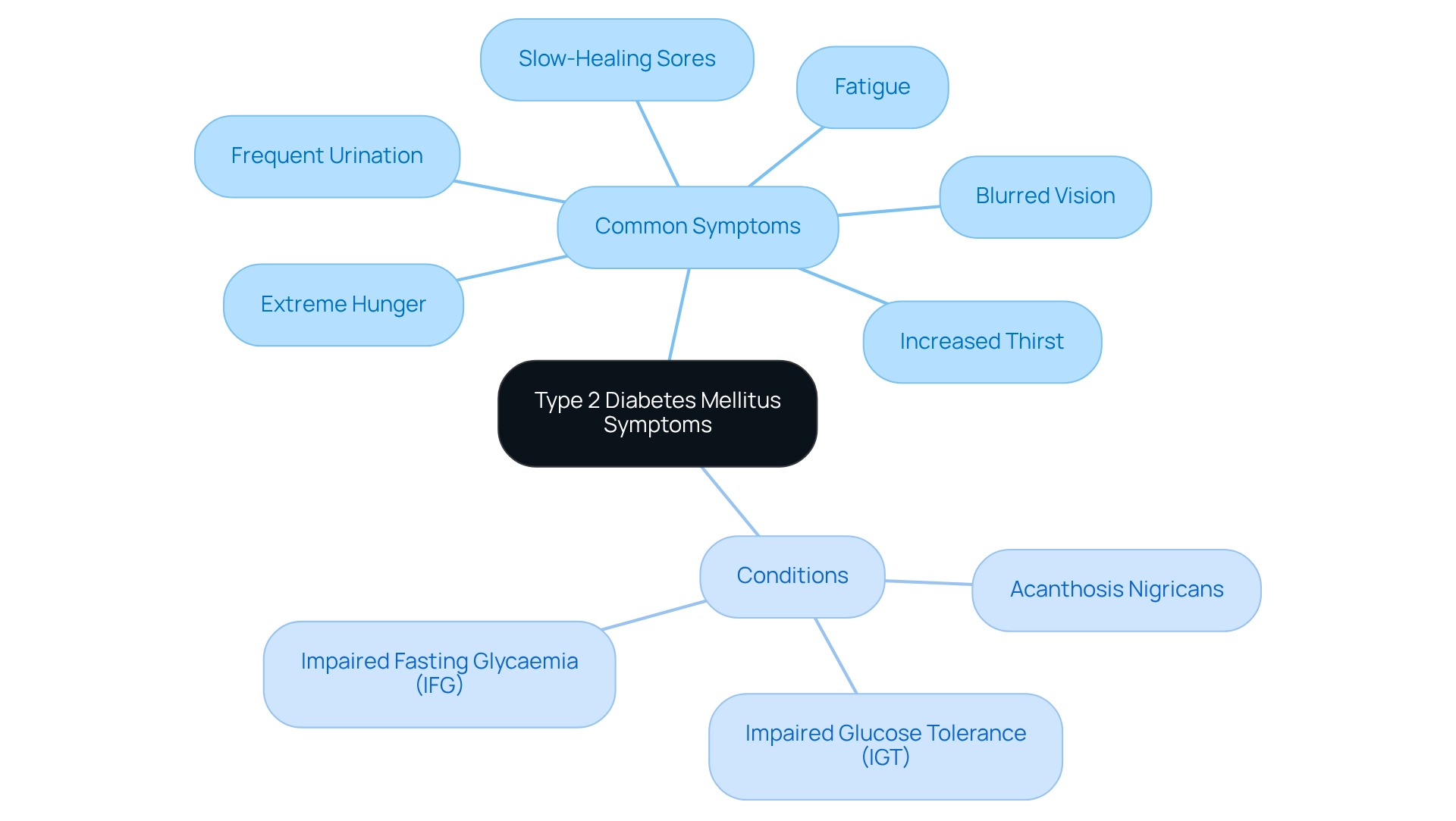
Managing Diabetes Mellitus Type 2: Strategies for Effective Care
Managing condition 2 requires a comprehensive strategy that includes lifestyle changes, medication compliance, and regular monitoring of blood sugar levels. It's essential to adopt a balanced diet that emphasizes whole grains, a variety of fruits and vegetables, and lean proteins. Regular physical activity is crucial for maintaining a healthy weight and improving insulin sensitivity.
Medications, such as metformin, are often prescribed to help regulate blood sugar levels effectively. However, the significance of lifestyle changes cannot be overstated. Research shows that 41.9% of individuals with Type 2 reported making lifestyle modifications based on information acquired online from a study involving 1,250 members of The Norwegian Diabetes Association. This highlights the potential influence of available resources and community assistance, like T2DSolutions, in promoting positive wellness practices.
T2DSolutions acts as a beneficial resource center for recently diagnosed patients, providing education and community support to improve disease management. Regular consultations with healthcare providers are essential for monitoring progress and making necessary adjustments to treatment plans. Instruction on self-management strategies empowers individuals to take control of their well-being, enhancing their capability to navigate the complexities of managing chronic conditions.
Furthermore, involvement in online support groups has shown a notable increase in the likelihood of embracing advantageous lifestyle modifications. In fact, only 6% of participants in a recent study reported utilizing these online groups in the past year, indicating a potential area for increased engagement. Moreover, 31% of participants in a USA study indicated using condition-specific social media platforms, which serve as important venues for sharing experiences and seeking guidance related to lifestyle changes.
As we look toward 2025, effective strategies for Type 2 conditions continue to evolve, emphasizing personalized care plans that integrate the latest dietary recommendations and expert insights from healthcare professionals. A newly released meta-epidemiological study from ACLM compiles suggestions from 78 clinical practice guidelines for significant chronic conditions and overall wellness promotion, underscoring the importance of dietary oversight. Nutritionists advocate for meal plans that prioritize nutrient-dense foods while minimizing processed sugars and unhealthy fats.
By nurturing a supportive community through platforms like T2DSolutions and utilizing available resources, individuals can enhance their management journey and improve their overall quality of life. Remember, you're not alone in this journey, and we are here to support you every step of the way.
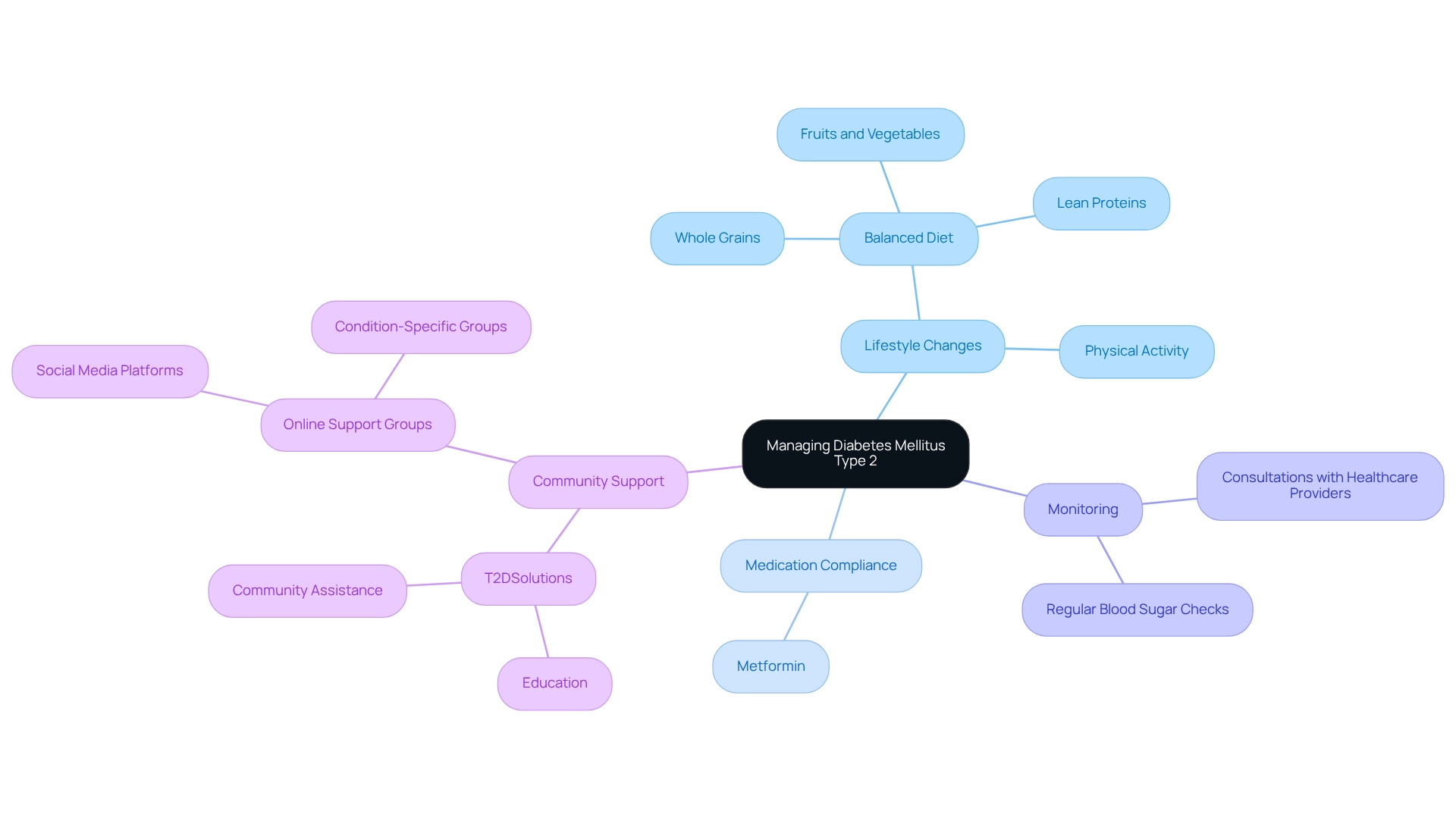
Complications of Diabetes Mellitus Type 2: Understanding the Risks
Complications arising from diabetes mellitus type 2 can be profound and multifaceted, significantly impacting overall health. Among the most serious complications are cardiovascular diseases, affecting nearly 68% of individuals with blood sugar issues and potentially leading to heart attacks and strokes. A recent case study on temporal trends in cardiovascular disease (CVD) risk assessment and management among Type 2 patients highlights the importance of lifestyle changes and regular screenings, especially in developing nations where these risks are on the rise.
Additionally, nerve damage, known as neuropathy, can lead to debilitating pain and loss of sensation, particularly in the extremities. Kidney damage, or nephropathy, is another critical concern, with high blood sugar being a leading cause of kidney failure in the United States. It's understandable to feel overwhelmed by these possibilities, but knowing the risks can empower you to take action.
Eye problems, including diabetic retinopathy, can result in vision loss if not properly managed. Foot complications, which can lead to infections and even amputations, are common among individuals with poorly managed blood sugar levels. The risk of infections and skin issues increases as well, necessitating careful attention and observation.
Current data indicate that the overall projected expenses of health conditions related to diabetes in the U.S. reached an astonishing $413 billion in 2022, highlighting the financial strain of these complications. It's worth noting that the median county-level occurrence of diagnosed cases decreased from 9.7 per 1,000 individuals in 2004 to 9.0 per 1,000 individuals in 2020, suggesting some progress in managing the illness. Furthermore, in 2017-2018, there were 18,169 newly diagnosed cases of type 1 in children and adolescents under 20, underscoring persistent management challenges among various age groups.
Healthcare professionals stress the essential importance of effective management. Regular medical check-ups are vital for monitoring these complications and implementing preventive measures. As research continues to advance, understanding the latest discoveries on health risks associated with diabetes mellitus type 2 remains crucial for both patients and healthcare providers. Remember, you're not alone in this journey; we are here to support you every step of the way.

Exploring Type 3 Diabetes: The Connection to Cognitive Health
This condition highlights the important idea that insulin resistance in the brain significantly contributes to the onset of Alzheimer's disease. Research shows that individuals diagnosed with diabetes mellitus type 2 face an increased risk of cognitive decline and dementia. This risk primarily arises from the harmful effects that elevated blood sugar levels can have on brain function. Understanding this connection underscores the critical need for effective blood glucose management—not just for physical health, but also for preserving cognitive function.
Recent studies have revealed that about 70% of the lifetime costs associated with supporting a person with dementia are borne by families. This statistic emphasizes the profound impact that cognitive health has on both individuals and their loved ones. The link between insulin resistance and Alzheimer's disease is becoming clearer, with ongoing research identifying potential biomarkers that could help monitor developmental delays related to these conditions. Certain metabolites have shown inverse associations with developmental quotients, suggesting their promise as biomarkers in this context.
As we look toward 2025, investigations into the third type of this condition and its effects on cognitive health are advancing. Recent findings indicate that individuals with diabetes mellitus type 2 are at a notably higher risk for Alzheimer's. This highlights the importance of comprehensive care approaches that address both condition management and cognitive health. A notable case study titled "Effects of Metformin on Cognitive Measures in T2DM" suggests that metformin treatment may not provide cognitive benefits for T2DM patients, pointing to the necessity for further research into effective treatment strategies aimed at neurocognitive outcomes.
Additionally, recommendations for enhancing dementia care navigation include:
- Formalizing the navigator role
- Expanding access to programs that can offer practical insights for healthcare providers
By recognizing and addressing these connections, healthcare professionals can better support individuals as they navigate the complexities of this condition and its potential cognitive implications. As Sir Zumla, a recognized expert in the field, emphasizes, integrating blood sugar management with cognitive health strategies is essential for improving outcomes for those affected. You're not alone in this journey, and we are here to support you every step of the way.
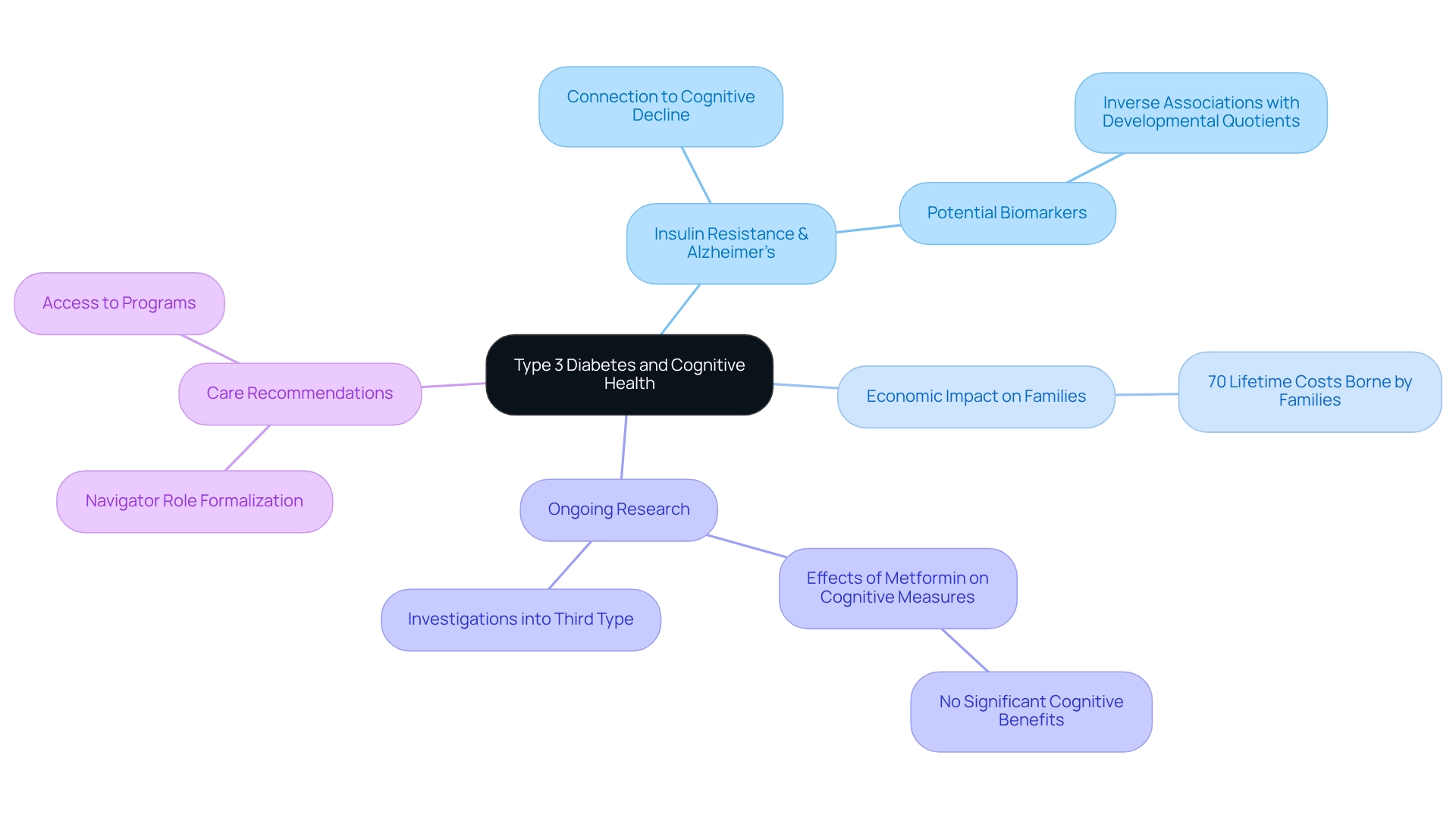
Building a Supportive Community: Resources for Diabetes Management
Creating a supportive community is essential for individuals navigating the complexities of Type 2 diabetes. Engaging with resources such as health education programs, support groups, and online forums can significantly enhance both knowledge and emotional well-being. At T2DSolutions, we aim to be a key resource hub, providing access to valuable information and support tailored for newly diagnosed patients.
Organizations like the American Diabetes Association and local wellness departments also offer an abundance of resources focused on education, lifestyle coordination, and community engagement.
Research shows that involvement in diabetes support groups can lead to enhanced wellness outcomes. For instance, individuals with baseline A1c levels of 9% or higher who engaged in structured support programs experienced average healthcare cost savings of $2,780 in the first year. This underscores the financial benefits of effective management strategies. Moreover, studies have demonstrated that community involvement can result in better compliance with treatment plans and improved overall wellness indicators, such as systolic blood pressure, which was notably enhanced in 3 of the 9 studies.
Connecting with others who share similar experiences fosters resilience and provides encouragement, making the journey of managing this condition less isolating and more empowering. Diabetes educators emphasize the importance of building supportive networks, noting that peer support can enhance motivation and accountability. As Vincent Bryan Salvador, M.D., points out, "It must be noted that the baseline mean HbA1C were higher in both interventions DE and DE+PS groups compared to the control group, and this may be associated with greater reduction in HbA1C in the intervention groups and may skew the finding."
As the landscape of managing this condition evolves, the role of community support remains a crucial element in achieving long-term health objectives and enhancing quality of life for individuals impacted by Type 2 diabetes. At T2D Solutions, we are dedicated to offering the essential resources and assistance to aid individuals in navigating their health journey. However, it’s important to recognize that further research is needed to explore the long-term effects of peer support interventions on diabetes management. Remember, you're not alone in this journey—we are here to support you every step of the way.

Conclusion
Understanding and managing Type 2 diabetes is essential in today's health landscape, where its prevalence continues to rise. This article has explored the multifaceted nature of the condition, including its definition, risk factors, common symptoms, and effective management strategies. Recognizing the importance of early diagnosis and lifestyle modifications can significantly improve health outcomes and empower individuals to take control of their diabetes journey.
It's important to acknowledge that Type 2 diabetes is not just a personal health issue but a public health challenge requiring collective action. Community support and resources, such as those provided by T2DSolutions, play a crucial role in enhancing awareness, education, and management of the disease. From understanding diagnostic criteria to recognizing the interconnectedness of diabetes and cognitive health, we encourage you to engage actively with the available tools and support networks.
Ultimately, fostering a supportive community and prioritizing education are vital steps toward managing Type 2 diabetes effectively. By taking proactive measures and leveraging the resources at your disposal, you can navigate your health journey with confidence. This leads to better outcomes not only for yourself but for society as a whole. The path to managing Type 2 diabetes is challenging, but with the right knowledge and support, a healthier future is within reach. Remember, you're not alone in this journey; we are here to support you every step of the way.
Frequently Asked Questions
What is Diabetes Mellitus Type 2?
Diabetes Mellitus Type 2 is a chronic metabolic condition characterized by insulin resistance and a relative shortage in insulin production, leading to elevated blood glucose levels (hyperglycemia). Unlike Type 1 diabetes, individuals with Type 2 can still produce insulin but their bodies struggle to use it effectively.
What are the potential health complications associated with Type 2 diabetes?
Serious health issues that can arise from Type 2 diabetes include cardiovascular disease, kidney damage, and neuropathy.
How prevalent is Type 2 diabetes globally?
As of 2021, around 537 million adults were living with Type 2 diabetes, with projections estimating this number will rise to 643 million by 2030. This increase is linked to rising obesity levels, sedentary lifestyles, and genetic factors.
What factors contribute to insulin resistance in Type 2 diabetes?
Factors such as obesity and lack of exercise can intensify insulin resistance, creating a harmful cycle that exacerbates the condition.
What is the importance of early diagnosis and treatment of Type 2 diabetes?
Early diagnosis and treatment are crucial to mitigate long-term effects of Type 2 diabetes. Understanding the condition helps individuals make informed choices about their health and can lead to better health outcomes.
What resources does T2DSolutions provide for individuals with Type 2 diabetes?
T2DSolutions aims to be a supportive resource center for glucose-related education and community assistance, offering essential information and tools to help individuals navigate their health journey.
What is the collaborative approach to managing Type 2 diabetes?
A collaborative approach includes lifestyle changes, medical treatments, and community support, which are vital for improving health outcomes and enhancing the quality of life for those affected by the condition.
What are the main types of diabetes?
The main types of diabetes are Type 1, Type 2, and gestational diabetes. Type 2 accounts for approximately 90-95% of all diabetes cases worldwide.
What are the diagnostic criteria for Diabetes Mellitus Type 2?
The criteria include: 1. A fasting plasma glucose level of 126 mg/dL (7.0 mmol/L) or higher. 2. A 2-hour plasma glucose level of 200 mg/dL (11.1 mmol/L) or higher during an Oral Glucose Tolerance Test (OGTT). 3. An A1C level of 6.5% or higher. 4. A random plasma glucose level of 200 mg/dL (11.1 mmol/L) or higher in a patient showing classic symptoms of hyperglycemia.
Why is it important for patients to understand blood glucose control?
Understanding blood glucose control is essential for preventing complications related to diabetes and improving overall health outcomes.
